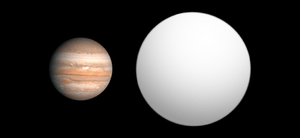TrES-4b
| Exoplanet | List of exoplanets | |
|---|---|---|
 | ||
| Parent star | ||
| Star | GSC 02620-00648 A[1] | |
| Constellation | Hercules | |
| Right ascension | (α) | 17h 53m 13.0502s[2] |
| Declination | (δ) | +37° 12′ 42.595″[2] |
| Distance | approx. 1400[2] ly (approx. 430[2] pc) | |
| Spectral type | F8[1] | |
| Orbital elements | ||
| Semi-major axis | (a) | 0.05091 ± 0.00071[1] AU |
| Eccentricity | (e) | 0 |
| Orbital period | (P) | 3.553945 ± 0.000075 d |
| Inclination | (i) | 82.86 ± 0.33[1]° |
| Semi-amplitude | (K) | 86.1 m/s |
| Physical characteristics | ||
| Mass | (m) | 0.919 ± 0.073[1] MJ |
| Radius | (r) | 1.799 ± 0.063[1] RJ |
| Surface gravity | (g) | 7.04 ± 1.12 m/s² (0.718 ± 0.114 g) |
| Temperature | (T) | 1782 ± 29[1] |
| Discovery information | ||
| Discovery date | 2006-2007 | |
| Discoverer(s) | Mandushev et al.[3] | |
| Discovery method | Transit | |
| Discovery status | Published | |
| Other designations | ||
TrES-4b | ||
| Database references | ||
| Extrasolar Planets Encyclopaedia | data | |
| SIMBAD | data | |
| Exoplanet Archive | data | |
| Open Exoplanet Catalogue | data | |
TrES-4b is an extrasolar planet, and one of the largest exoplanets ever found, after WASP-12b, WASP-17b, CT Chamaeleontis b (though the latter may be a brown dwarf) and GQ Lupi b. It was discovered in 2006, and announced in 2007, by the Trans-Atlantic Exoplanet Survey, using the transit method. It is approximately 1,400 light-years (430 pc) orbiting the star GSC 02620-00648, in the constellation Hercules.[3]
TrES-4 orbits its primary star every 3.543 days and eclipses it when viewed from Earth. The planet is 0.919 times as massive as Jupiter but 1.799 times the diameter, the largest planet ever found at the time (next to WASP-17b, found on 1 May 2009), giving it an average density of only about 0.333 grams per cubic centimetre, approximately the same as Saturn's moon Methone. This made TrES-4 both the largest known planet and the planet with the lowest known density at the time of its discovery.[1][3]
TrES-4's orbital radius is 0.05091 AU, giving it a predicted surface temperature of about 1782 K. This by itself is not enough to explain the planet's low density, however. It is not currently known why TrES-4 is so large. The probable causes are the proximity to a parent star that is 3–4 times more luminous than the Sun as well as the internal heat within the planet.[1][3]
A 2008 study concluded that the GSC 06200-00648 system (among others) is a binary star system allowing even more accurate determination of stellar and planetary parameters.[1]
See also
- List of extrasolar planet extremes
- UY Scuti, the largest known star
- WASP-17b, another large exoplanet
References
- 1 2 3 4 5 6 7 8 9 10 Daemgen, S.; Hormuth, F.; Brandner, W.; Bergfors, C.; Janson, M.; Hippler, S.; Henning, T. (2009). "Binarity of transit host stars - Implications for planetary parameters" (PDF). Astronomy and Astrophysics. 498: 567–574. arXiv:0902.2179. Bibcode:2009A&A...498..567D. doi:10.1051/0004-6361/200810988.
- 1 2 3 4 Brown, A. G. A; et al. (2016). "Gaia Data Release 1. Summary of the astrometric, photometric, and survey properties". Astronomy and Astrophysics. 595. A2. arXiv:1609.04172. Bibcode:2016A&A...595A...2G. doi:10.1051/0004-6361/201629512. Gaia Data Release 1 catalog entry
- 1 2 3 4 Mandushev, Georgi; et al. (2007). "TrES-4: A Transiting Hot Jupiter of Very Low Density". The Astrophysical Journal Letters. 667: L195–L198. arXiv:0708.0834. Bibcode:2007ApJ...667L.195M. doi:10.1086/522115.
External links
![]()
- "Team finds largest exoplanet yet". BBC News. 7 August 2007.
- "New monster planet 'could float on water'". ABC News (Australia). 7 August 2007.
- Than, Ker (August 6, 2007). "Largest Known Exoplanet Discovered". Space.com news service. Retrieved 2007-08-07.
- Muir, Hazel (August 6, 2007). "Largest known exoplanet puzzles astronomers". NewScientist.com news service. Retrieved 2007-08-07.